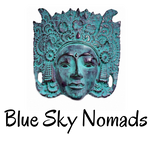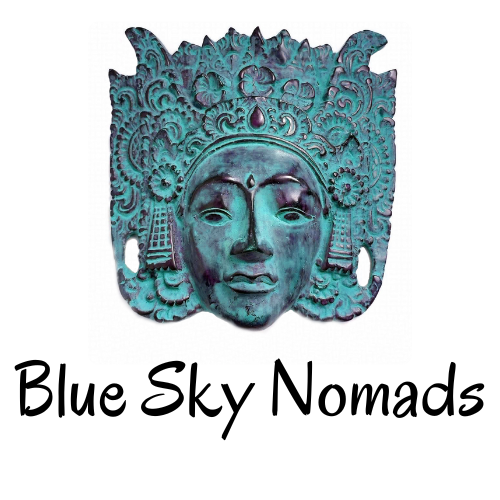All About Ikat's
About Zenzoey’s Ikats

Bill inspecting and choosing the Ikats from weaving village
Zenzoey’s Ikats are personally sourced from women’s weaving groups and villages by Diane and Bill Newland. Because there is no middleman involved more money goes directly to the weavers and helps the women and village society. By purchasing from us you help to keep these traditions alive for future generations. Diane and Bill travel the backroads and off beat paths to find the best Ikats for Zenzoey. All Zenzoey’s Ikats are hand-dyed, hand-woven on a back-strap loom, and ethically sourced with a fair price paid to the weavers. At Zenzoey we are passionate about keeping the art of weaving and natural dyeing alive. This trip it took us 2 long weeks in primitive local villages to find the best top quality Ikats we were looking for. After many hours and many villages we found the highest quality, best workmanship and the best weavers.We believe that when you hold a handmade textile in your hands, the soul of the weaver is communicating with you. What it tells you, and how interesting the story is, is determined by the physical circumstances of its manufacture, and by the state of mind of the maker. Is it handmade? Was is made on a back-strap loom to earn the woman's the right to marry, or assure her respected place in the village society? There is always a story tell and Zenzoey works hard to find the best ones for you.
What are Ikats and how are they made
The word "ikat" (pronounced ee-kat) comes from a Malay term that means "to tie" or "to bind." The islands of Indonesia are famous for their Ikat style of textiles and have a rich tradition of naturally dyed handwoven cloth. Much of the cloth is used for ceremonies, wedding, funerals and is passed down through families for generations. Most of the designs have ritual significance, others tell a story or illustrate life on a particular island.

It all begins with growing of cotton. The cotton is used to make the threads that the weaver will use to make the Ikat.
The weaver stretches their warp or weft cotton thread onto a wooden frame and ties strands of palm leaf or plastic raffia around small bundles of threads. After hours or days of tying, the bindings begin to form patterns: stylized plants and animals, motifs declaring clan and status, pictures and words that illustrate ancient myths and recent events.

The villager above is binding and tying the design onto the bamboo frame getting ready for the dying process.
When the cotton threads are dyed, the bindings resist the color, and the sections of thread they enclose remain white. At this point, the weaver might remove the bindings, arrange the threads on the loom, and begin to weave. Or, they could remove some bindings, add others, and re-dye with a second color. By adding and subtracting bindings throughout the process, they imbue their work with varied depths of color. The whole process is extremely time consuming taking weeks or months to complete this process.


After dying the bound threads the pattern emerges as seen above and is then strung onto the back-strap loom and is ready for the weaving process.

Each ikat is woven on a back-strap loom as the weaver sits on the ground.
Because the threads are dyed before putting on the loam as the weaver starts weaving they can't make each pass with thradel exact and it give a ghost like effect in the weaving. A characteristic of ikat textiles is an apparent "blurriness" to the design. The blurriness is a result of the extreme difficulty the weaver has lining up the dyed yarns so that the pattern comes out perfectly in the finished cloth. However, the blurriness that is so characteristic of ikat is often prized by textile collectors. Each Ikat can take 6-12 months or longer to complete. It is a very tedious process but results in an exquisite Ikat.
Natural Dyeing Process
All of Zenzoey.com Ikat's are all made using natural dyes. Beautiful soft tones as well as strong and vibrant colors are produced using only natural dyes. The process to produce strong colors that last is often a long one. The women collect leaves, plants, bark and even dirt to make their dyes for the Ikat.
The blue color is made from the indigo plant which is grown and harvested locally. It is first soaked in water mixed with lime powder. The lime reacts with the leaf and turns the water blue. It is them fermented for weeks to ensure the color is strong and will remain in the cloth. Thread is then soaked in the dye mix, beaten with a wooden mallet to send the color to the center of the thread, dried, then the process repeats numerous time depending on the desired color. The colors red, yellow, brown, green and black are produced with various roots and leaves, sometimes mixed together for varying color tones.


Natural bark, roots, leaves, dirt, and other vegetation is used to obtain the color for the Ikat.


Roots used to obtain natural colors. Dyes fermenting to get right color.
Trying to choose


Village Chief showing us their beautiful Ikats.

This is the daughter of the chief of the village. The patterns and colors used are handed down mother to daughter and are usually used in that peculiar village.

A typical village when you arrive, they bring out all their Ikats and other weaving styles and put them on display hoping that you will buy something. There are so many beautiful Ikats to choose from it is hard to decide.

